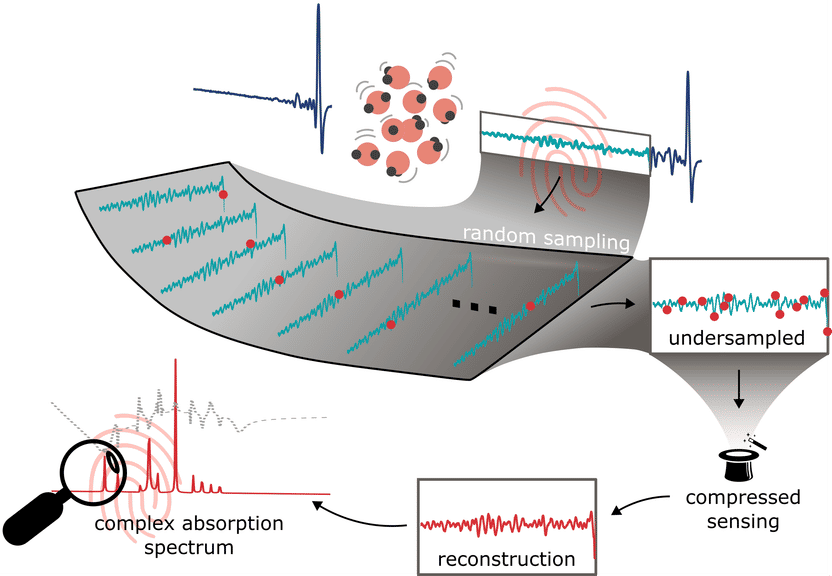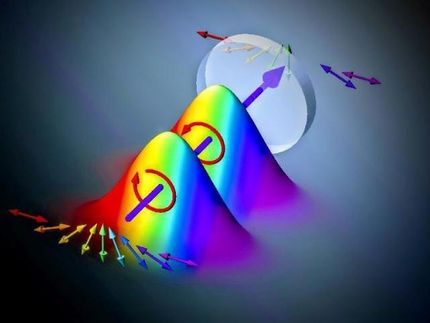Scientists accelerate spectroscopic analysis
"This innovation expands the application of compressed sensing to real-time spectroscopic measurement"
Ultrafast laser spectroscopy allows the ascertainment of dynamics over extremely short time scales, making it a very useful tool in many scientific and industrial applications. A major disadvantage is the considerable measuring time this technique usually requires, which often leads to lengthy acquisition times spanning minutes to hours. Researchers have developed a technique to speed up spectroscopic analysis. The results of the project led by Hanieh Fattahi, Research group leader at the Max-Planck-Institute of the Science of Light, in collaboration with industrial partners from Germany and France, were recently published in the Journal of Ultrafast Science.

Visual summary of compressed sensing of field-resolved molecular fingerprints.
@ Hanieh Fattahi / MPL Reprint von DOI: 10.34133/ultrafastscience
Ultrashort pulses play a significant role in spectroscopic applications. Their broad spectral bandwidth enables simultaneous characterization of the sample at various frequencies, eliminating the need for repeated measurements or laser tuning. Moreover, their extreme temporal confinement allows for temporal isolation of the sample’s response from the main excitation pulse. This response, which carries comprehensive spectroscopic information lasts from tens of femtoseconds to nanoseconds (10−15 to 10−9 seconds) and is commonly probed by a shorter pulse at various time delays. When merged with other techniques, such as multi-dimensional coherent spectroscopy or hyperspectral imaging, ultrafast spectroscopy facilitates the identification of unknown constituents. However, the ambition of real-time measurements faces obstacles, primarily due to the extensive data recording required across the high bandwidth spectrum for each pixel, introducing considerable delays in data capture, extending processing time, and increasing data volume.
Researchers have developed a technique to speed up spectroscopic analysis. Kilian Scheffter, a doctoral student working with Hanieh Fattahi, head of the “Femtosecond Fieldoscopy” group at MPL explains: ”The response of molecules to ultrashort excitation pulses is typically sparse in many samples, which implies that the response occurs only at specific frequencies known as molecular fingerprints. By strategically randomizing the measurement points in time, an established approach called compressed sensing can efficiently reconstruct the signal by using fewer data points than the limit dictated by the Nyquist criterion. However, the main challenge has been to change the temporal overlap of the probe pulses and the femtosecond excitation pulses randomly. Collaborating with our partners in Germany and France, we've successfully employed acoustic waves to modulate this temporal overlap randomly. This innovation expands the application of compressed sensing to real-time spectroscopic measurement."
“Accelerating time domain spectroscopy offers several advantages, for example in simplifying the label-free imaging of fragile specimens, real-time environmental monitoring and open-air diagnostics of toxic and hazardous gases, and molecular fieldoscopy” says Dr. Hanieh Fattahi.
Original publication
Other news from the department science
Most read news
More news from our other portals
See the theme worlds for related content
Topic World Spectroscopy
Investigation with spectroscopy gives us unique insights into the composition and structure of materials. From UV-Vis spectroscopy to infrared and Raman spectroscopy to fluorescence and atomic absorption spectroscopy, spectroscopy offers us a wide range of analytical techniques to precisely characterize substances. Immerse yourself in the fascinating world of spectroscopy!

Topic World Spectroscopy
Investigation with spectroscopy gives us unique insights into the composition and structure of materials. From UV-Vis spectroscopy to infrared and Raman spectroscopy to fluorescence and atomic absorption spectroscopy, spectroscopy offers us a wide range of analytical techniques to precisely characterize substances. Immerse yourself in the fascinating world of spectroscopy!
























































